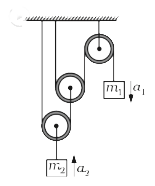A train starts from station A with uniform acceleration a1. For some distance and then groes with uniform retardation a2 for some more distance to come to rest at station B. The distance between stations A and B is 4km and the train takes 1/5h compete this journey. If accelerations are in km per mimute unit, then show that 1a1+1a2=x. Find the value of x.
The correct Answer is:2
To solve the problem, we need to analyze the motion of the train from station A to station B. Here's a step-by-step breakdown of the solution:
Step 1: Understand the motion of the train
The train accelerates from rest with acceleration a1 until it reaches a maximum velocity Vmax. After that, it decelerates with acceleration a2 until it comes to rest at station B. The total distance covered is 4 km, and the total time taken is 15 hours.
Step 2: Convert time to minutes
Convert the total time from hours to minutes:
Total time=15 hours=15×60 minutes=12 minutes
Step 3: Express distances and times
Let T1 be the time taken to accelerate to Vmax and T2 be the time taken to decelerate to rest. Thus, we have:
T1+T2=12 minutes
Step 4: Use kinematic equations
1. The distance covered during acceleration S1:
S1=12a1T21
2. The distance covered during deceleration S2:
S2=VmaxT2−12a2T22
3. The total distance is:
S1+S2=4 km
Step 5: Relate Vmax to T1 and T2
From the equations of motion, we have:
Vmax=a1T1andVmax=a2T2
Thus, we can express T1 and T2 in terms of Vmax:
T1=Vmaxa1andT2=Vmaxa2
Step 6: Substitute T1 and T2 into the total time equation
Substituting these into the total time equation gives:
Vmaxa1+Vmaxa2=12
Factoring out Vmax:
Vmax(1a1+1a2)=12
Step 7: Substitute into the distance equation
Substituting S1 and S2 into the distance equation:
12a1(Vmaxa1)2+Vmax(Vmaxa2)−12a2(Vmaxa2)2=4
This simplifies to:
V2max2a1+V2maxa2−V2max2a2=4
Combining terms:
V2max2a1+V2max2a2=4
Factoring out V2max2:
V2max2(1a1+1a2)=4
Step 8: Relate the two equations
From the total time equation, we have:
Vmax12=1a1+1a2
Substituting this into the distance equation gives:
V2max2⋅12Vmax=4
This simplifies to:
6=4
This leads us to the conclusion that:
1a1+1a2=18
Final Result
Thus, the value of x is:
x=18
The train accelerates from rest with acceleration a1 until it reaches a maximum velocity Vmax. After that, it decelerates with acceleration a2 until it comes to rest at station B. The total distance covered is 4 km, and the total time taken is 15 hours.
Convert the total time from hours to minutes:
Total time=15 hours=15×60 minutes=12 minutes
Let T1 be the time taken to accelerate to Vmax and T2 be the time taken to decelerate to rest. Thus, we have:
T1+T2=12 minutes
1. The distance covered during acceleration S1:
S1=12a1T21
2. The distance covered during deceleration S2:
S2=VmaxT2−12a2T22
3. The total distance is:
S1+S2=4 km
From the equations of motion, we have:
Vmax=a1T1andVmax=a2T2
Thus, we can express T1 and T2 in terms of Vmax:
T1=Vmaxa1andT2=Vmaxa2
Substituting these into the total time equation gives:
Vmaxa1+Vmaxa2=12
Factoring out Vmax:
Vmax(1a1+1a2)=12
Substituting S1 and S2 into the distance equation:
12a1(Vmaxa1)2+Vmax(Vmaxa2)−12a2(Vmaxa2)2=4
This simplifies to:
V2max2a1+V2maxa2−V2max2a2=4
Combining terms:
V2max2a1+V2max2a2=4
Factoring out V2max2:
V2max2(1a1+1a2)=4
From the total time equation, we have:
Vmax12=1a1+1a2
Substituting this into the distance equation gives:
V2max2⋅12Vmax=4
This simplifies to:
6=4
This leads us to the conclusion that:
1a1+1a2=18
Thus, the value of x is:
x=18
Topper's Solved these Questions
Similar Questions
A body travels along a straight line with uniform acceleration a1 for time t1 and with uniform acceleration a2 for time t2 for time t2. What is the average acceleration?
View SolutionA train starting from a railway station and moving with uniform acceleration attains a speed of 40km/h in 5 min. find its acceleration.
View Solution
Knowledge Check
- Question 1 - Select One
A train starts, from station A with uniform acceleration f1 for some distance and then goes with uniform retardation f2 for some more distance to come to rest at station B. The distance between the stations A and B is 4 km and the train takes 4 minutes to complete this journey. If f1 and f2 are in km-minute units, then 1f1+1f2=
A1B2C3D4 - Question 2 - Select One
A train starts from rest and moves with uniform acceleration α for some time and acquires a velocity v it then moves with constant velocity for some time and then decelerates at rate β and finally comes to rest at the next station. If L is distance between two stations then total time of travel is
ALV+V2(1α+1β)BLV−V2(1α+1β)CLV−V2(1α−1β)DLV+V2(1α−1β) - Question 3 - Select One
A starts from rest and moves with acceleration a1. Two seconds later B starts from rest and moves with an acceleration a2. If the displacement of A in the 5th second is the same as that of B in the same interval, the ratio of a1 to a2 is
A9:5B5:9C1:1D1:3
A train starting from a railway station and moving with uniform acceleration attains a speed 40km/h in 10 minutes. Find its acceleration.
View SolutionA train starts from a station and moves with a constant acceleration for 2 minutes. If it covers a distance of 400m in this period, find the acceleration.
View SolutionA body P starts from rest with an acceleration a1. After 2 seconds, another body Q starts from rest with an acceleration a2 from the same point. If they travel equal distances in the fifth second after starting of the motion of the P, then the ratio a1:a2 is equal to
View SolutionFind the relation between acceleration a1 and a2
 View Solution
View SolutionA train starts from station A and reaches B 15 minutes late when it moves with 40 km/hr and 24 minutes late when it goes 30 km/hr. The distance between the two stations is
View Solution

